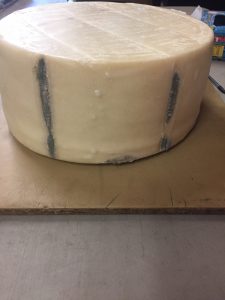Wednesday the 23rd was a town day for me and included cheese cutting for a cheese delivery to Seaman’s. I experienced mold when preparing to cut the cheese and was uncertain how to deal with it so I consulted Constantine when I did not find any accessible information in the Google Docs. The following is a transcription of the exchange; I am using PR to represent myself and CF to represent Constantine.
PR: (sent with a picture attached) “Is this mold anything to worry about?”
CF: “What does the other side look like?
And The bottom”
PR: (sent two photos) “Other side is relatively flawless. Bottom had some mold”
PR: (sent 1 photo) “Some mold in box”
CF: “Though the sight of that mold might be looked upon unfavorably by many of our Seaman’s customers, there is some awesome tasting cheese under that there mold.
I suggest cutting your wedge on both sides if there mold, and generously enough to then cut a half inch or so off the outside of that edge, and bring it home. You’ll end up with mold free shorter wedges.”
PR: “So cut the wedge 1/2″ back from the mold on both sides?”
CF: “What do you mean both sides? Cut a wide 2 lb wedge top to bottom from the wheel, spanning both sides of the mold.”
PR: (sent 1 photo) “Copy that, I think we will end up with more than 2 lbs”
CF: “Lay the wedge down and cut off 1/2 – 1″ from the widest side of the wedge, with all the mold and side wax on that rectangle, and your knife never touching mold.
It is suggested to sanitize as needed with quat, knife as well as board.”
Constantine was looking for 2 rectangular pieces of moldy cheese rind with 1/2″ of cheese on the inside of the rind to be brought home. What was brought home was 2 wedges of cheese with mold on the rind. How did this happen? How could we have improved the exchange so that the desired end product was produced?
I think an emphasis on the end product may have increased understanding. Before diving into the instructions for the cuts, Con might have described the end product he was looking for, 2 rectangular pieces of moldy cheese cut from two wedges of cheese, roughly .75″ wide.
I likened this exchange to putting something together from a kit using instructions. Because I did not have a clear picture of what I was trying to build or produce, I misunderstood the instructions and did not know the questions to ask to get me back on track.
Constantine was trying to have me cut one 2 lb wedge of cheese that had a stripe of mold on it, then cut 1/2″ of cheese behind the mold off this wedge, reserve the moldy cheese separately, then clean my knife and cutting board and cut the clean cheese left on the wedge into .5 lb portions for retail sale. As I continued cutting cheese and reached the second mold spot, I would repeat the process I used for the first piece of moldy cheese.
My key misunderstanding was a fixation on the idea of cutting both of the mold spots out of the cheese at once in one big wedge; because of this, I could not adequately process what Constantine was trying to convey; this led me to proceed without a full understanding and to a less than idea end product.
Below I have repeated the instruction that I did not understand clearly and below that have created an edited version of the instructions that I think would have made the instructions clear to me:
“I suggest cutting your wedge on both sides if there mold, and generously enough to then cut a half inch or so off the outside of that edge, and bring it home. You’ll end up with mold free shorter wedges.”
I suggest cutting your first wedge on both sides of the strip of mold on the right, and generously enough to then cut a half inch or so back from the inside of that moldy edge, and bring it home. You’ll end up with a mold free shorter wedge that can be cut up for Seaman’s. Repeat the process when you reach the other strip of mold.
I think these changes to the original instruction would have emphasized that I would be dealing with the mold spots separately, and that I would only be removing as much product as necessary to maximize the amount of product going to retail.
I am hopeful that we can continue to improve our communications here at AO to streamline our operation and promote understanding between ourselves and others.

8/25/17 Cheese Cutting

